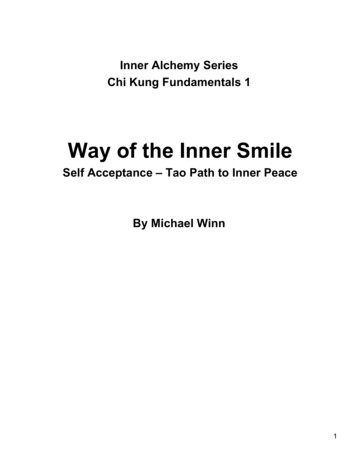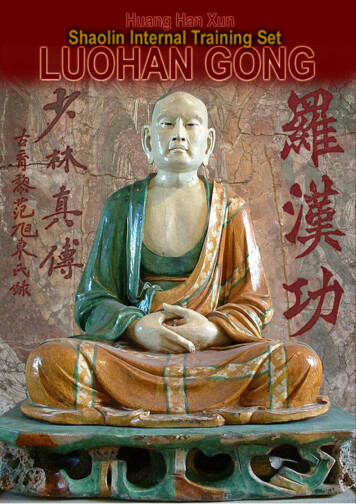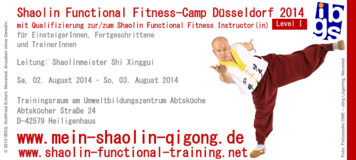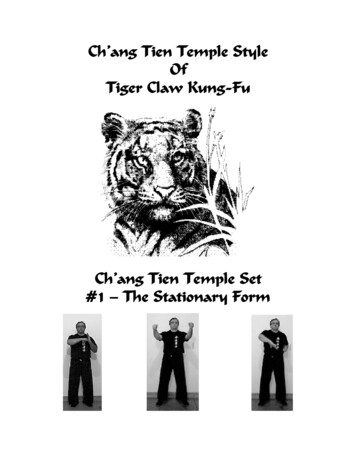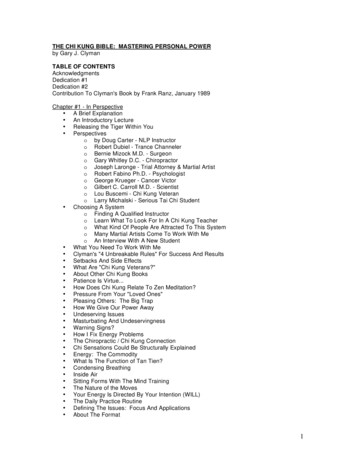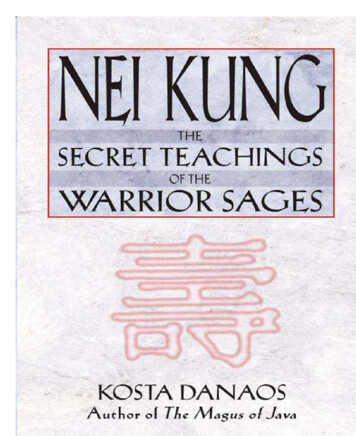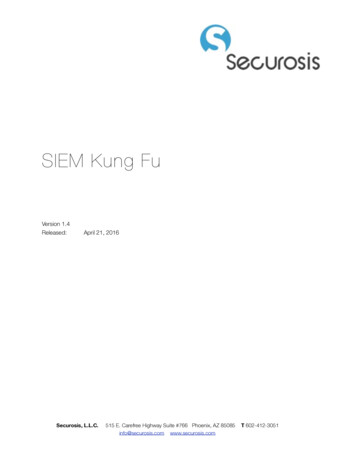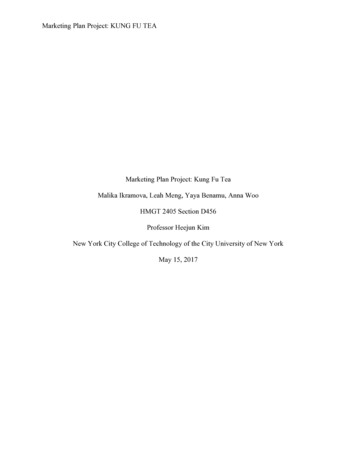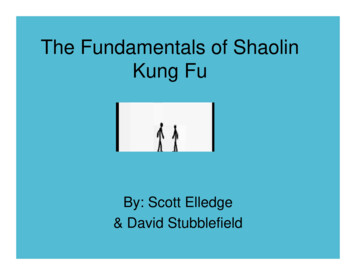
Transcription
The Fundamentals of ShaolinKung FuBy: Scott Elledge& David Stubblefield
History of the ShaolinTemple Breathing &Meditation Conditioning &Stretching Internal Styles External Styles Weapons
History of the Shaolin TempleThe word Shaolin is derived from Shaoshi Mountain and “lin”, the Chineseword for forest.This describes the geographic area of the first temple built in the HenanProvince around 495 A.D.
32 years later, an Indian Buddhist priest namedBodhidharma came to the temple, but was turnedaway by the head abbot, Fang Chang
Bodhidharma was determined and went to a nearbycave and meditated
Nobody knows exactly why, but Bodhidharma was then allowed into thetemple and he soon noticed that the monks were in poor physical health
He began teaching them movingexercises designed to enhance Chiflow and build strength.They consisted of 18 actions knownas the 18 Lohan movements or forms.
These 18 forms later evolved into 54 forms and then into 108 forms.These movements were the start of Shaolin Ch’uan or Shaolin Fist,later know as Kung Fu.
Over the years, due to repeated attacks and periods of inactivity due toreigning Imperial and regional leaders who feared the monks, other templeswere incorporated into Shaolin.The 5 main temples were:
The Henan Temple, the original temple and the one seenin Chinese Kung Fu movies.
The Fukien Temple, know as the “headquarters” during times whenHenan was either destroyed or under threat.
The Kwangtung Temple, known as the snake temple.
The Wutang Temple, known as the Tiger temple.
The O Mei Shan Temple, known as the Crane Temple.
Breathing and MeditationMeditation is the essence of Chan Buddhism and Shaolin Kung Fu and it is thesoul of Bodhidharma’s teachings
Meditation simply means to be fully aware of the moment.
It is done in a number of different postures such as sitting, standing, head stand,and Iron Bar, which is stretching out between two benches with your head on oneand your heels on the other.
These postures were usually held for several hours at a time and some monksachieved such high levels of sitting practice that they would meditate for a weekstraight with no break for sleep.
Some monks have skills so high that they abstain from lying down ever againand at the highest level, some even die in state, which means to pass on inseated meditation with out falling over.
Breathing is an important part of meditation and there aretwo basic types of breathing.
The first is Hou T’ien Chi, the “breath after your birth”.It is used to relax the mind and body, and heighten sensitivity. Itinvolves positive breathing in which the abdomen expands wheninhaling and contracts when exhaling.
The other is Hsien T’ien Chi, the “Breath before birth”.It is referred to as negative breathing and involves contracting theabdomen when inhaling and expanding while exhaling.
Conditioning and StretchingConditioning and stretching are essential to all Martial Arts, including Kung Fu.But the Shaolin conditioning and stretching trainingsystem is too vast, deep, and numerous to account for infull detail, but the following are some aspects of thesystem.
I Chin Ching: These are basic stretching exercises based onthe 49 postures of the I Chin Ching or Muscle-Tendon-ChangeClassic that Bodhidharma is attributed to have initiated.
These 49 postures are designed to develop abalance of strength and flexibility by workingon the muscles and tendons and each postureis usually practiced for 49 breaths each.
Yin/Yang Conditioning: The Human body has 434voluntary muscles composed of two types of fibers, whiteand red. This form of conditioning helps in part to develop abalance of the slow twitch or red fibers as well as fast twitchor white fibers. It is referred to as postive/negitiveconditioning
Endurance punching and kicking: This was carriedout indoors in the winter.It consisted of a set of exercises that are designed todevelop endurance and stamina.
Outdoor Conditioning: This was carried out outdoors in the fall. It wasdesigned for endurance and strength as well as balance on unevenoutdoor surfaces.
Iron Bone Training: This is probably the most famousof the training done by the Shaolin. It’s carried out todensify the skin and bones by mechanical vibration orcontrolled stress caused by impact of the forearms,legs, and palms on either a punching bag, tree, water,or into hot sand.
Internal StylesThere are numerous Internal Styles, but the twomost well known are Tai Chi Ch’uan and Qigong.
Tai Chi Ch’uan: means “the Grand Ultimate Fist” and is often referred to asmeditation in motion. It is one of the more popular internal styles that is practicedby the general public in China and the West.
Although it is commonly considered to be a slowgentle form that is like meditation in motion, inactual it is the most devastating of all martial artswhen trained for that purpose
Although it is commonly considered to be a slowgentle form that is like meditation in motion, inactual it is the most devastating of all martial artswhen trained for that purposeYet, because of its subtlety, fluidity and the decadesof practice that it requires to truly master it, fewpeople care to pursue it for more than exercise andholistic purposes
Tai Chi training, when carried out with the martial aspects in mind,enhances sensitivity, yielding ability (like a snake), rooting, fluidity ofmotion (swimming in air, reeling silk), and counterstrikes that involvereturning the opponent’s energy.
The ancient masters of the art were so skilledthat a fly landing on their arm would set theirentire body into motion, a sparrow sitting on thepalm of the hand was unable to fly, every punchor kick thrown in their direction were brushedaway effortlessly and they delivered thedevastating earth-shaking strikes by sinking,rooting and discharging their chi.
Qigong is the art of developing vital energy, particularly forhealth, vitality, mind expansion and spiritual cultivation.
It is a major part of Shaolin kung fu and isintertwined into every external style.
It involves the building of Chi and directing it to parts of the body forprevention from injury or to an opponent with the intent to injure.
All great kung fu makes use of energy training to develop internalforce, without which it remains at its external, mechanical level,considered by Chinese martial artists as rough and low-class.
Hence, a kung fu master may look,and actually is, gentle, yet with hisinternal force he can cause muchdamage to his opponent if he wishes.
Hence, a kung fu master may look,and actually is, gentle, yet with hisinternal force he can cause muchdamage to his opponent if he wishes.His internal force does not diminishwith age, and he can apply it forpeaceful use in his daily living
External StylesThese kung fu styles may generally be divided into 3 classes: ShaolinTemple styles, Temple-derived non-temple styles, and Family stylesand there are two major divisions in Shaolin kung fu.External styles vary into the hundreds and the majority of themare based on animal movements.
The Southern Shaolin styles, which are predominantly hand technique oriented,consist of Southern Praying Mantis and the 5 animals that make up the FiveAnimal Fist: Tiger, Dragon, Leopard, Snake and White Crane.
And the Northern Shaolin styles, which put more emphasis onkicks and foot techniques. It consisted of Northern PrayingMantis, Black Crane, and Black Tiger.
Southern Praying Mantis rarely emphasizes one type of technique.The Mantis hook is employed, but so are numerous other trapping andcontrolling maneuvers.
The typical closed fist of other styles is absent from the southern sect,which instead favors the mantis fist, a modification of the leopard punch,but concentrating all of the striking force through a single finger.
Stances are low to moderate, but firmly anchored to the ground andthere is tremendous use of the knees, elbows and low, powerful kicks.
Southern Tiger utilizes a hard, external approach to combatthat meets force with force and is very likely to maim or kill anopponent because of the nature of the counterattack.
It’s primary hand weapons are the closed fist and tiger claw.While kicking maneuvers are usually low to middle range kicks of great power.
One studies Tiger to develop bones, muscles and tendons.The emphasis is on strength and dynamic tension,culminated in short, hard, snappy moves.
The Dragon represented two of the ancient elements, earth andwater, endowing the creature with powers of elusion and power.
Dragon style relies heavily upon evasion as a tactic and evades primarilyby rotation of the upper or lower torso with little or no stance movement.
It employs pinpoint strikes to vulnerable targetsand also heavily uses tiger-like punches andclawing techniques, snake-like stance shifts,and leopard-like hit and run strikes to weakena physically superior adversary.
Leopard style is construed as a soft subsystem and is used todevelop speed and strength, for it is the fastest of the tiger family.
The main weapon is the leopard fist. The fist is formed in such a way that it canjab, rake or crush on any surface withoutalteration, striking soft points in theanatomy and structural weak points.
The back of the hand is often used in breaking while a variationwith the first two fingers extended is used for attacks to the eyes.
Southern Snake style is distinguished from most of the other animal stylesby the introduction of circular movements in its parries and attacks.
This introduction of circlescharacterizes the transition to ahigher style. The circles themselvescan be compared to the dynamics ofYin and Yang in Taoism.
Circular attacks (viewed as Yin) arecountered by direct attacks (Yang).Similarly, straight techniques arecountered by circular ones.
The emphasis on snake style is hitting weak pointsalong the Chi meridians as in acupuncture.
It has been suggested by some practitioners ofacupuncture, that the meridian routes were mapped basedon preferred sites for mosquito bites.Many bites induced discomfort in distant parts of the body.
The modern snake kung fu style is a collection ofolder styles which have now died out.It’s range of techniques, however, reflect theinfluence of three different styles.
Viper consisted of intimidating strikes that could inflict heavy psychological damage bydrawing lots of blood without causing life-threatening damage. Its trademark was thetongue strike – two fingers aiming often at arteries and veins.
Cobra, which did not emphasize highlyrecognizable or showy techniques, but rathervery serious strikes to nerves and pressurepoints. Its characteristic hand technique was anopen hand with the thumb curled underneath inorder to maintain dynamic tension.
Python relied on the leopard fist for its pinpoint strikes and included grappling.
The two universal aspects of snake techniques are pin point openhand strikes and twisting arm postures to disguise one’s line of attack.
Most snake kung fu practitioners use an upright, mobile stancewhich allows for rapid advances and sidestepping footwork.Using fast, alternating hand jabs, the practitioner drills at anopponent, sidesteps, counterattacks and drives home his attack.
One day an old man was meditating near a pond when he observed abeautiful white stork, when out of the forest came a gorilla. He fearedthat the ape would destroy the bird, but was amazed by the bird’selusiveness and ability to peck vital parts of the gorilla’s anatomy.
Major characteristics of this system include wide-armed,wing-like movements, high kicking, and the crane’s beak, ahand weapon made by joining the fingertips firmly.
As the defender physically evades an assault, the torsoturns with force that accelerates the force of a strike,making even minor contacts painful to the attacker.
And evasive footwork forces the opponent to workharder to target in on the kung fu practitioner, who inturn has the opportunity to tire his opponent beforelaunching a definitive counterattack.
Footwork in the White Crane is legendary, targets being anythingfrom the head to groin. Bottom of the foot kicks are effective, as arecrushing stomps, generated at close range and with great speed.Other kicks are designed to dislocate or unbalance opponents.
The founder of Northern Praying Mantis was the boxer WangLang, who developed the method of combat around 1600 A.D.He took the basic movements of a praying mantis andincorporated the erratic footwork of the monkey style.
Northern Mantis splinters off into differentstyles like Seven Stars or Plum BlossomPraying Mantis, but common to allNorthern Mantis kung fu styles is the useof the mantis hook.
The hook is used for striking, blocking and parrying. Advancedpractitioners learn to lock onto the opponent to employ stickingor leading techniques, but never maintain a strong grip.Mantis further employs breaking of joints, particularly at the elbow.
Black Crane kung fu constitutes the hand sets of the Shaolin Craneand provides a short range style for boxing useful to tall boxers.It includes throws and locks but is missing the intricate forms so that itcould be studied by the general populace or military personnel.
The movements are a collection of the ancient cranestyle, some tiger and the motion of snake.Because the exercises were intended to teachcharacter and spirit, the style inherited the storkstance long before white crane kung fu itself wasintroduced into China.
Black Tiger kung fu originated in the HenanShaolin Temple.
It has more emphasis on footwork thanthe Southern Shaolin kung fu forms andbears some resemblance to Eagle style.
The list of animal styles goes on and on, one for j
Qigong is the art of developing vital energy, particularly for health, vitality, mind expansion and spiritual cultivation. It is a major part of Shaolin kung fu and is intertwined into every external style. It involves the building of Chi and directing it to parts of the body for prevention from injury or to an opponent with the intent to injure. All great kung fu makes use of energy training .
